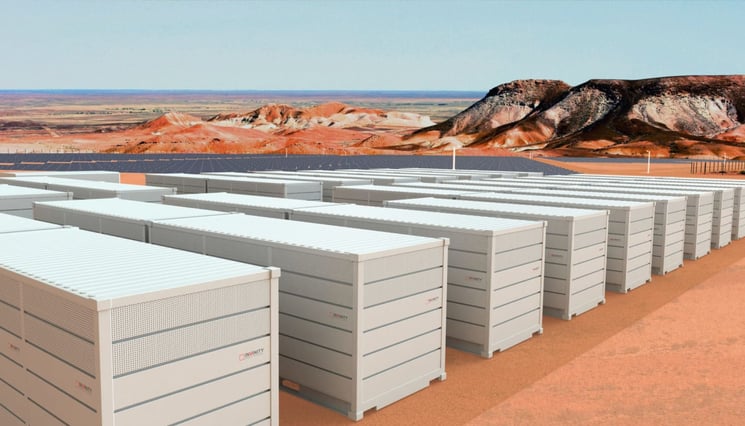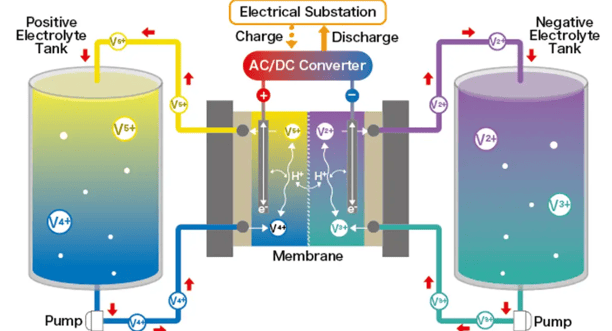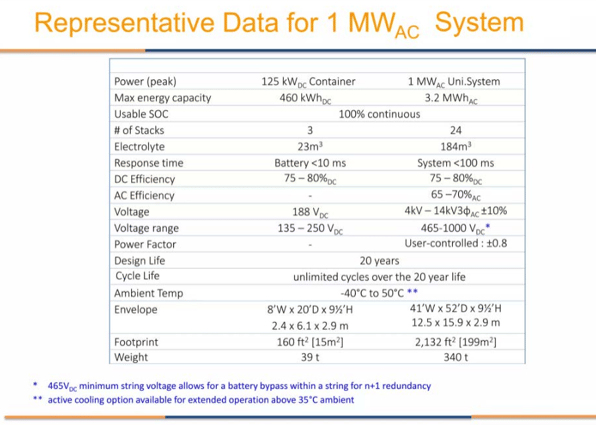Harnessing Solar Energy for All Your Needs
Redox Flow Battery
A Vanadium Redox Flow Battery is a type of rechargeable flow battery that uses vanadium ions in different oxidation states to store and release energy. The battery consists of two electrolyte tanks (containing vanadium in different oxidation states), a cell stack where the electrochemical reactions occur, and pumps to circulate the electrolytes between the tanks and the cell stack.
Integration with a 10 MW Solar Farm
Energy Storage:
Load Balancing: VRFBs can store excess energy generated during peak sunlight hours and release it during periods of low sunlight or at night, helping to balance the load and ensure a steady power supply.
Grid Stabilization: By providing quick response energy storage, VRFBs can help stabilize the grid, especially in regions with high penetration of solar power.
Scalability:
VRFBs are highly scalable. The power capacity (MW) of the system is determined by the size of the cell stack, while the energy capacity (MWh) is determined by the size of the electrolyte tanks. This means the system can be easily scaled up or down based on the needs of the solar farm.
Long Cycle Life:
VRFBs have a long cycle life, often exceeding 10,000 cycles with minimal degradation. This makes them suitable for long-term energy storage solutions, offering a reliable backup for the solar farm.
High Efficiency:
The round-trip efficiency of VRFBs is typically around 70-85%, which is competitive with other storage technologies. This ensures that a significant portion of the solar energy stored in the battery can be recovered and used when needed.
Safety and Environmental Benefits:
VRFBs are considered safer than some other battery technologies because they don’t pose a fire risk and the electrolytes are non-flammable. Additionally, vanadium is recyclable, making VRFBs an environmentally friendly option.
Flexibility in Placement:
Since the energy storage capacity can be expanded by increasing the size of the electrolyte tanks, VRFBs can be tailored to the specific needs of the solar farm. The batteries can be housed in containers that can be placed on-site or nearby, providing flexibility in design and deployment.
Applications in a 10 MW Solar Farm
Daily Load Shifting: Store excess solar energy during the day and discharge it during peak demand periods in the evening or night.
Renewable Energy Smoothing: Mitigate the effects of intermittency in solar generation by providing a smooth and consistent power output.
Backup Power: Serve as a backup power source during grid outages or periods of low solar generation.
Peak Shaving: Reduce the demand on the grid during peak hours by discharging stored energy, potentially lowering energy costs.
Considerations
Initial Cost: VRFBs can have a higher initial cost compared to other battery technologies, though their long cycle life and scalability can offset this over time.
Space Requirements: VRFB systems require significant space for the electrolyte tanks and other components, so adequate space must be available on or near the solar farm site.


Contact Solar Agri for Inquiries
Vanadium Redox Flow Batteries are well-suited for integration with a 10 MW solar farm, offering reliable, scalable, and environmentally friendly energy storage. They can enhance the overall efficiency and reliability of the solar farm, making them a valuable component in renewable energy projects.


Vanadium Redox Flow Battery (VRFB)
Provide a general summary of the services you provide, highlighting key features and benefits for potential clients.


Charging Time
Charging time = Battery capacity / Power input
Charging time = 5 kWh / 5 kWh per hour = 1 hour
Space Required for 100 MW VRFB
A 100 MW Vanadium Redox Flow Battery (VRFB) system requires approximately 20,000 to 40,000 cubic meters of space, depending on the storage duration (e.g., 4 to 8 hours of storage). This translates to a footprint of about 5 to 10 acres, including space for electrolyte tanks and infrastructure. The exact space requirement depends on the design and energy density, typically around 20-30 kWh per cubic meter.
Advantages of VRFB
Safe discharge: VRFBs are safe and non-flammable.
Efficiency: 75-85% efficiency is typical.
Solar input: 5 kWh of DC energy from solar panels, indicating a direct charging system.
Battery capacity: 5 kWh battery with a one-hour discharge capability.
MPPT: Used to optimize solar energy capture.
Space efficiency: 1 CBM can store up to 20 kWh of energy, making VRFB systems scalable.
Higher solar input: A larger solar array can provide more energy, potentially expanding the storage capacity.
Vanadium Redox Flow Batteries (VRFBs) battery charge retention.
Self-Discharge: VRFBs have very low self-discharge rates. The vanadium electrolyte solution, stored in tanks, retains its energy for long periods without significant loss. Unlike traditional batteries (such as lithium-ion), VRFBs can retain their charge for extended periods, potentially even up to a year, with minimal degradation.
Temperature Range (15°C to 35°C): The temperature variation you mentioned is within the typical operating range for VRFBs. These systems are quite stable within this range and can operate effectively without significant performance degradation. The electrolyte solution does not react adversely to moderate temperature changes, so energy loss due to temperature shifts would be minimal.
If you charge a VRFB with 50 kWh and leave it unused for a year with temperatures ranging between 15°C to 35°C, the energy stored would largely remain the same, with very little reduction due to self-discharge. The energy loss over time would be negligible.


